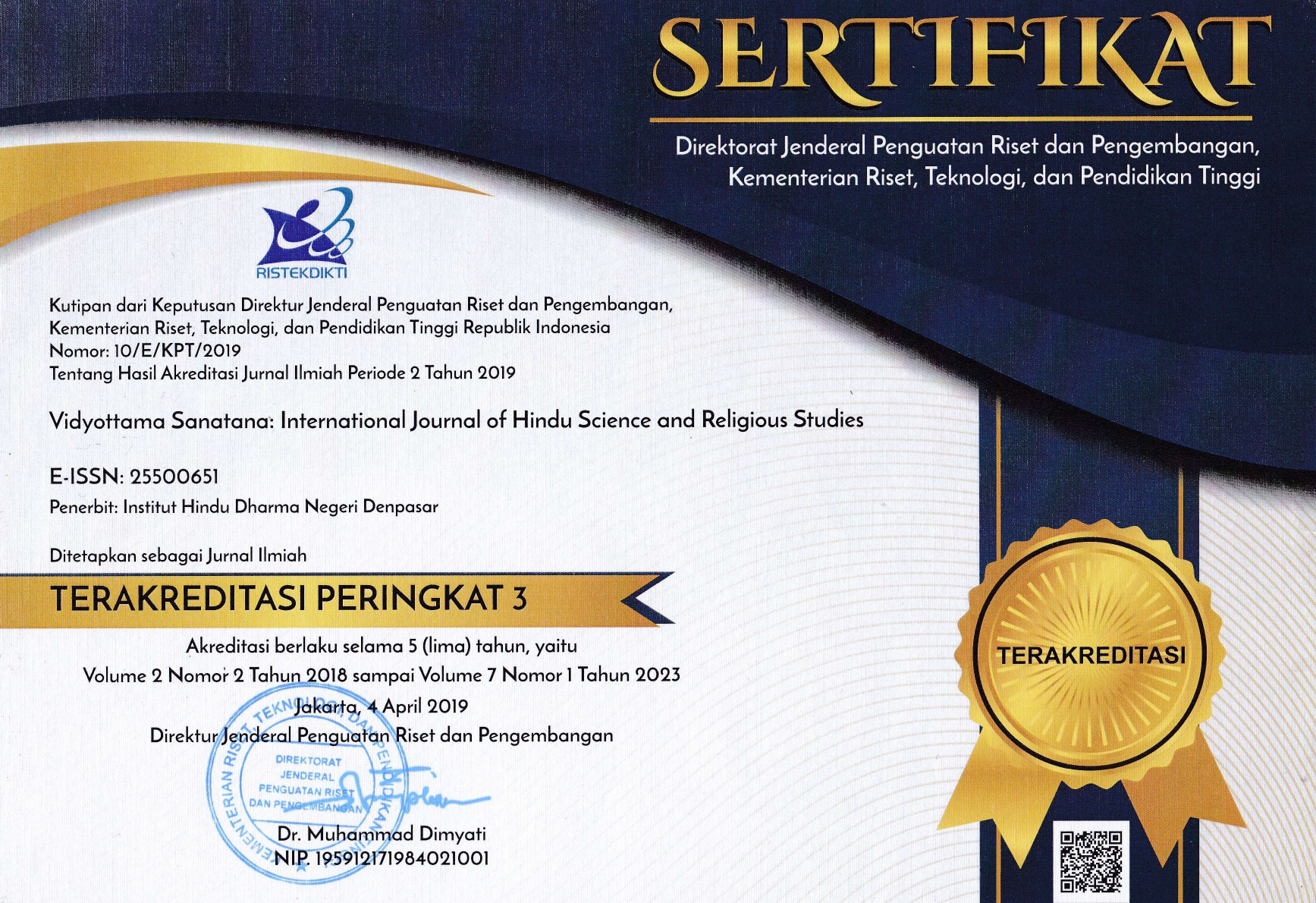THE ARCHITECTURE OF PALINGGIH ULAM AGUNG AND PEDAU: SYMBOLIC ARTEFACTS OF THE NUSA PENIDA, COASTAL COMMUNITY’S BELIEF SYSTEM IN HINDUISM OSMOSIS
DOI:
https://doi.org/10.25078/vidyottama.v7i1.2350Keywords:
palinggih 'bangunan suci HIndu', masyarakat pesisir, osmosis, Nusa PenidaAbstract
The architecture of the palinggih ‘Balinese shrine’ is generally built based on the design of a sacred Hindu building according to the guidelines of traditional Balinese architecture, but different from the two architectural forms of shrines in Nusa Penida, Bali. This study focuses on the transformation of the belief system of Nusa Penida’s local coastal community belief system, which is realized into ulam agung (king of fish) and pedau (traditional sailboat) sacred buildings. The results of the study show that the transformation of the metaphor architectural shrine occurs because of the mastery, placement, and conversion of cultural, social, symbolic, and economic capital, that crosses individual and collective habitus in the realm of the Nusa Penida local coastal community belief system. The system of people’s belief in local gods undergoes a process of osmosis into gods in the pantheon of Hinduism. The socio-religious practice is also influenced by their level of knowledge, reasoning, and experience of the architectural form of the shrine as a symbolic Hindu religious building.
References
Aska. (2023). Metaphor Architecture: Definition, Principles, Figure and Their Works. Available on https://www.arsitur. com/2018/09/architecture-metaphor-comp lete.html (accessed on January 10, 2023).
Barker, C. (2005) Cultural Studies: Theory and Practice. London: Sage Publications, p. 93.
Buda, Jro Mangku Made (2007) Nusa Penida Chronicle. Surabaya: Paramita
Bourdieu, P. (2016) the Arena of Cultural Production: A Study of the Sociology of Culture, Yogyakarta: Discourse Creation, p. xv-xx.
Foucault, Michel (2002) Power/Knowledge, Discourse on Power/Knowledge (Trans. Yudi Santosa). Yogyakarta: Landscape Culture.
Geria, I Made (1997) “Nusa Penida Survey”, Classical Archeology Publishing News, No.2, p.7.
Geriya, I Wayan (2008) Transformation of Balinese Culture Entering the XXI Century. Surabaya: Paramita.
Harker, R, Cheelen, M. and Wilkes, C. (2009) (Habitus X Capital) + Realm = Practice. The Most Comprehensive Introduction to the Thoughts of Pierre Bourdieu. Yogyakarta: Jalasutra
Haryatmoko (2016) Dismantling the Regime of Certainty. Yogyakarta: PT. Kanisius, p. 45.
Holt, Claire. (2000). Tracing the Traces of the Development of Art in Indonesia (Trans. RM Soedarsono). Bandung: Arti.line.
Maswinara, I W. (2004). Veda Sruti Rg Veda Samhita Sakala Sakha Mandala IV, V, VI, VII. Surabaya: Paramita.
Mircea, Eliade (2002) the Myth of the Eternal Return or Cosmos and History. New Jersey: Princeton University Press, p. 4.
PHDI (Hindu Dharma Council of Indonesia) (2010) the Results of the Great Congregation Hindu Dharma Council of Indonesia. Jakarta: PHDI Pusat.
Piliang, YA & Jaelani, J. (2018). Contemporary Cultural Theory: Exploring Signs and Meanings. Yogyakarta: Aurora.
Suhardana, KM (2015) Guidelines for Pinandita. Surabaya: Paramita, p. 289.
Titib, M. (2008). “Synergy of Religions and Culture in Balinese Society”. Ed. IBG Yudha Triguna. Balinese Culture and Cultural Capital in Local, National, Global Binoculars. Denpasar: Master’s Program in Religion and Culture at the Indonesian Hindu University Denpasar.
Vedananda, I.P.M.A.J.D. (2020). Devata Puja Samhita. Depictions of the Gods and Sets of Puja Mantras. Surabaya: Paramita cooperates with the Bali Province MGPSSR.


















